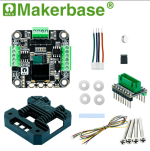Are the steps per mm for that axis accurate? If you set up a ruler does it move 10mm up or down repeatably if you ask it too?
Steps per mm is not my problem here. The zero creeps when doing repeated moves. I don't hear it missing steps, so I'm assuming stuff moves slightly inbetween moves.
I'll try to do your test. I expect it to move up during the test. I might be able to use it as my creep calibration.
I'll try to do your test. I expect it to move up during the test. I might be able to use it as my creep calibration.
Yes what I wondering is if the counterweight or belt tension or something is causing you to get a different distance moved than you expected and if it is consitent or random. If it moves up and down by the right amount repeatably that is good, if not that is a problem.
I would still just use an encoder.Steps per mm is not my problem here. The zero creeps when doing repeated moves. I don't hear it missing steps, so I'm assuming stuff moves slightly inbetween moves.
I'll try to do your test. I expect it to move up during the test. I might be able to use it as my creep calibration.
That just easily fixes everything.
These are either available as a affordable additional pcb that you can mount on your current stepper motors or as a while unit incl the stepper motor.
Do I need something else or is it just a drop in replacement for the stepper driver?
Btw, I already ordered some...
Btw, I already ordered some...
You mean in the case of a whole new unit?Do I need something else or is it just a drop in replacement for the stepper driver?
As long as it's the same NEMA size and it roughly uses the same current (and sometimes voltage), it's just a matter of dropping in.
Keep in mind that they are a bit bigger obviously, since there is a entire encoder on the back.
no I think that is just a break-out board to be able to mount it on a breadboard.Does the little board with only the green connector simply replace the stepper driver on my CNC shield?
But maybe you can share a link/information about the product?
I really don't know but have a look at this video maybe it will help
I saw that video. I've also seen them advertised as drop in replacements for 3d printers. I just don't know if that's the same for the CNC shield. I think so, but 'the wish might be the father of the thought'.
What happens if you rezero at the finishing position & run a new series?...it should return to z=0 and move to a new angle. It returns to a point that's around 1cm above the original ('mechanical') 0.
I get bored 
I'm running tests now to see if I can do that automatically by using creep correction.
Another option might be to make it go below zero, force missing steps and call that reset that as zero.

I'm running tests now to see if I can do that automatically by using creep correction.
Another option might be to make it go below zero, force missing steps and call that reset that as zero.
In the end it's basically trying to find all kinds of solutions that can be easily fixed all at once.I'm running tests now to see if I can do that automatically by using creep correction.
The end of a move down makes more noise than the end of a move up.
The mic vibrates more at the end of a down move than an up move.
I added a z creep correction of -0.85mm for each down move.
The mic vibrates more at the end of a down move than an up move.
I added a z creep correction of -0.85mm for each down move.
I get bored
I'm running tests now to see if I can do that automatically by using creep correction.
Another option might be to make it go below zero, force missing steps and call that reset that as zero.
The servos should allow a reasonable gain in accuracy. If more correction is needed perhaps a hard limit switch position that can serve as a true zero after so many positions are measured?In the end it's basically trying to find all kinds of solutions that can be easily fixed all at once.
A calibration process is always needed.If more correction is needed perhaps a hard limit switch position that can serve as a true zero after so many positions are measured?
Actually, maybe that's even the thing that goes wrong here.
I know from experience that the distance of a CNC also needs to be calibrated on a regular basis.
Coincidentally a few days ago I ordered an all in one ESP32 board from the same brand with TMC2209 Steppers and a touchscreen display to use as a base for the electronics. I am interested to see what the Stealthchop2 in the TMC2209 drivers can do, if it is quiet enough to be on all the time. It was also very cheap for what it is including wifi and bluetooth etc.I saw that video. I've also seen them advertised as drop in replacements for 3d printers. I just don't know if that's the same for the CNC shield. I think so, but 'the wish might be the father of the thought'.
https://github.com/makerbase-mks/MKS-DLC32?tab=readme-ov-file
- Home
- Design & Build
- Software Tools
- Klippel Near Field Scanner on a Shoestring

